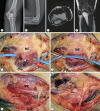Cubital Tunnel Syndrome Caused by Anconeus Epitrochlearis Muscle
- PMID: 30196659
- PMCID: PMC6129750
- DOI: 10.3340/jkns.2018.0033
Cubital Tunnel Syndrome Caused by Anconeus Epitrochlearis Muscle
Abstract
Objective: We evaluated the clinical manifestation and surgical results following operative treatment of cubital tunnel syndrome (CuTS) caused by anconeus epitrochlearis (AE) muscle.
Methods: Among 142 patients who underwent surgery for CuTS from November 2007 to October 2015, 12 were assigned to the AE group based on discovery of AE muscle; 130 patients were assigned to the other group. We analyzed retrospectively; age, sex, dominant hand, symptom duration, and weakness in hand. Severity of the disease was evaluated using the Dellon classification and postoperative symptom were evaluated using disability of arm shoulder and hand (DASH) and visual analogue scale (VAS) scores. Surgery consisted of subfascial anterior transposition following excision of AE muscle.
Results: AE muscle was present in 8.5% of all patients, and was more common in patients who were younger and with involvement of their dominant hand; the duration of symptom was shorter in patients with AE muscle. All patients showed postoperative improvement in symptoms according to DASH and VAS scores.
Conclusion: The possibility of CuTS caused by AE muscle should be considered when younger patients have rapidly aggravated and activity-related cubital tunnel symptoms with a palpable mass in the cubital tunnel area. Excision of AE muscle and anterior ulnar nerve transposition may be considered effective surgical treatment.
Keywords: Anconeus epitrochlearis; Anterior subfascial transposition; Cubital tunnel syndrome; Ulnar nerve.
Conflict of interest statement
No potential conflict of interest relevant to this article was reported.
Figures


Similar articles
-
The prevalence of the anatomical variation in a Turkish population: supernumerary muscle-anconeus epitrochlearis.Surg Radiol Anat. 2022 Oct;44(10):1409-1415. doi: 10.1007/s00276-022-03021-7. Epub 2022 Sep 23. Surg Radiol Anat. 2022. PMID: 36151223 Review.
-
The anconeus epitrochlearis muscle may protect against the development of cubital tunnel syndrome: a preliminary study.J Neurosurg. 2016 Dec;125(6):1533-1538. doi: 10.3171/2015.10.JNS151668. Epub 2016 Feb 12. J Neurosurg. 2016. PMID: 26871208
-
Anconeus Epitrochlearis Muscle Associated With Cubital Tunnel Syndrome: A Case Series.Hand (N Y). 2019 Jul;14(4):477-482. doi: 10.1177/1558944718762566. Epub 2018 Mar 27. Hand (N Y). 2019. PMID: 29582694 Free PMC article.
-
Prevalence and Clinical Manifestations of the Anconeus Epitrochlearis and Cubital Tunnel Syndrome.Hand (N Y). 2020 Jan;15(1):69-74. doi: 10.1177/1558944718789412. Epub 2018 Jul 20. Hand (N Y). 2020. PMID: 30027762 Free PMC article.
-
Cubital tunnel syndrome - a review and management guidelines.Cent Eur Neurosurg. 2011 May;72(2):90-8. doi: 10.1055/s-0031-1271800. Epub 2011 May 4. Cent Eur Neurosurg. 2011. PMID: 21547883 Review.
Cited by
-
The prevalence of the anatomical variation in a Turkish population: supernumerary muscle-anconeus epitrochlearis.Surg Radiol Anat. 2022 Oct;44(10):1409-1415. doi: 10.1007/s00276-022-03021-7. Epub 2022 Sep 23. Surg Radiol Anat. 2022. PMID: 36151223 Review.
-
Location of Ulnar Nerve Branches to the Flexor Carpi Ulnaris during Surgery for Cubital Tunnel Syndrome.J Korean Neurosurg Soc. 2023 Jan;66(1):90-94. doi: 10.3340/jkns.2022.0128. Epub 2022 Sep 8. J Korean Neurosurg Soc. 2023. PMID: 36071568 Free PMC article.
-
Dynamic Compression of the Ulnar Nerve Associated With the Anconeus Epitrochlearis Muscle: Do We Really Know Everything?J Hand Surg Glob Online. 2022 Dec 22;5(4):585-587. doi: 10.1016/j.jhsg.2022.11.002. eCollection 2023 Jul. J Hand Surg Glob Online. 2022. PMID: 37521541 Free PMC article.
-
Accessory flexor carpi ulnaris: case report and review of the literature.BJR Case Rep. 2020 Apr 30;6(3):20200010. doi: 10.1259/bjrcr.20200010. eCollection 2020 Sep 1. BJR Case Rep. 2020. PMID: 32922841 Free PMC article.
-
The anatomical variations of the cubital tunnel in a South African body donor sample.Surg Radiol Anat. 2024 Jun;46(6):777-785. doi: 10.1007/s00276-024-03327-8. Epub 2024 Mar 29. Surg Radiol Anat. 2024. PMID: 38551675 Free PMC article.
References
-
- Assmus H, Antoniadis G, Bischoff C, Hoffmann R, Martini AK, Preissler P, et al. Cubital tunnel syndrome - a review and management guidelines. Cent Eur Neurosurg. 2011;72:90–98. - PubMed
-
- Boero S, Sénès FM, Catena N. Pediatric cubital tunnel syndrome by anconeus epitrochlearis: a case report. J Shoulder Elbow Surg. 2009;18:e21–e23. - PubMed
-
- Bozentka DJ. Cubital tunnel syndrome pathophysiology. Clin Orthop Relat Res. 1998;351:90–94. - PubMed
-
- Byun SD, Kim CH, Jeon IH. Ulnar neuropathy caused by an anconeus epitrochlearis: Clinical and electrophysiological findings. J Hand Surg Eur Vol. 2011;36:607–608. - PubMed
LinkOut - more resources
Full Text Sources
Other Literature Sources

